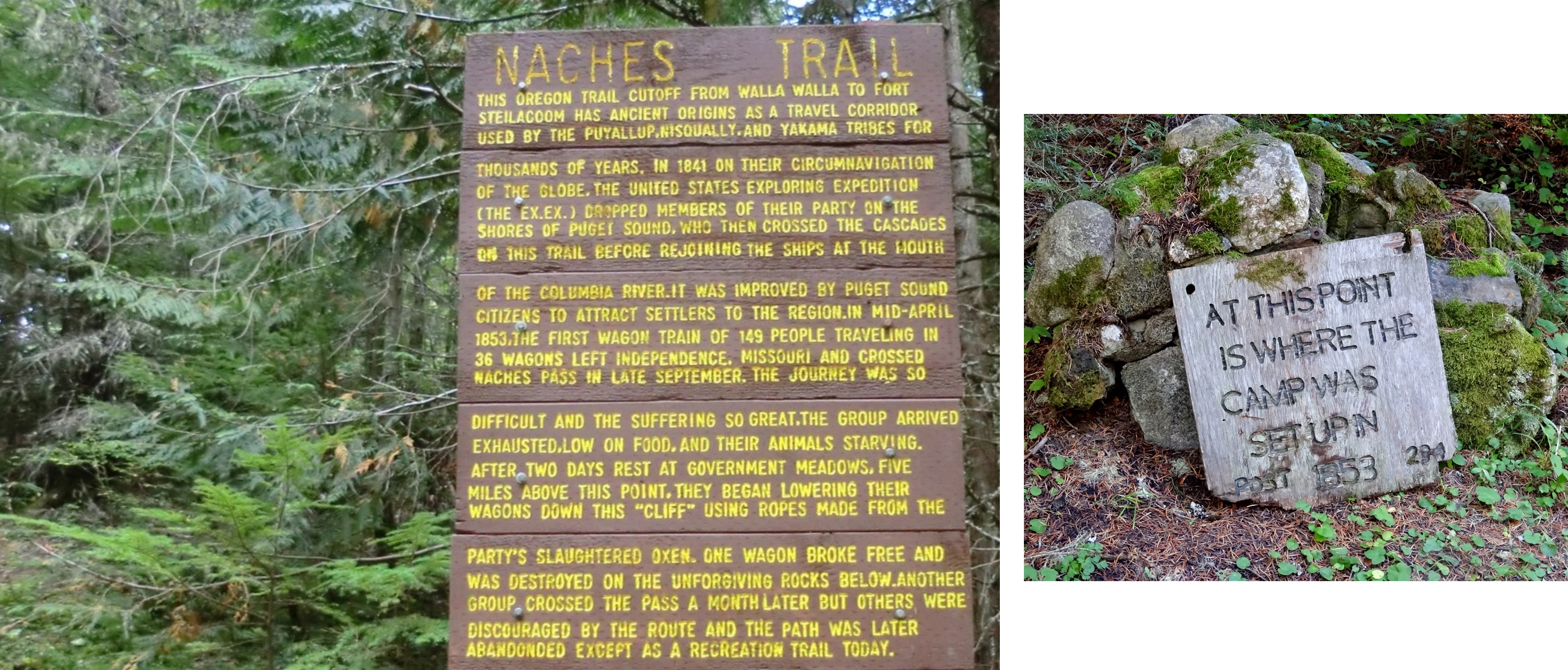For thousands of years the trail over Naches pass was a major Native American trade route for Salish tribes. The pass itself is 4,934 feet and 0.8 miles east of the PCT and the Mike Urich cabin.
Typically, a pass is the lowest point in a ridgeline that connects two watersheds. Often that means the headwaters of opposite flowing creeks almost touch. That does not quite describe Naches Pass. On the west side it's a traditional pass with Meadow Creek flowing west from the crest. But the east side is a dry route of relatively gradual slopes down to where the North and Middle Forks of the Little Naches River come together 5.4 miles from the pass. Rough dirt roads offer the possibility of driving over the pass in a capable vehicle.

History
In 1839 The Hudson's Bay Company, was seeking a route over the Cascade mountains from Walla Walla to Fort Nisqually in southern Puget Sound. In the summer of 1841 Lieutenant Robert E. Johnson was dropped off on the shores of Puget Sound and proceeded east over the Cascades via the Naches Pass, arriving at Fort Okanogan. He then took a boat down the Columbia River back to his ship.
In 1853 a road route over Naches Pass was scouted and blazed (marked), intended to make overland immigration to Puget Sound easier. That same year Captain George B. McClellan was also seeking a route through the Cascades (see my notes on Yakima Pass). McClellan's failure to find a lower route (Snoqualmie Pass) helped the advocates of the Naches route when he agreed to commit federal funds to building the road over Naches Pass, thus claiming success on his orders to build a road over the Cascades.
That September the Longmire wagon train followed the blazes and cut their way to Naches Pass, arriving at Fort Steilacoom (Enumclaw) in mid-October. Three weeks later the Mitchell wagon train followed. The Naches Pass wagon road never became popular. In addition to the difficult descent from Naches Pass (eased in 1854), it also required 68 crossings of the Naches and Little Naches Rivers east of the pass and multiple crossings of the White River on the west side.
The following year, 1854, the US army tasked Ft. Steilacoom with completing and improving the road. That fall two more wagon trains came through, the Ebey and Meeker parties.
The fate of the Naches Pass road was perhaps doomed with the outbreak of the Yakima Indian War (1855-1858). Only Indians and the Army used the road. Also, In early 1855, Lieutenant Abiel Tinkham had already reported on the superiority of the Snoqualmie Pass route. Following the Indian wars, the Naches Pass route was used almost exclusively by stockmen who drove their herds both ways over the pass on a regular basis until the turn of the century. A 1943 proposal for state highway 168 to run over Naches Pass was never built.

The Cabin
Local forester Mike Urich built the original cabin at the meadows. Born in Bosnia 1888, he died March 20, 1957 and was buried in Enumclaw.
 In 1992 the cabin was replaced by the
Sno-Jammers
Snowmobile club and dedicated to Mike Urich. A Boeing CH-47 Chinook helicopter delivered the pre-cut logs. The Sno-Jammers maintain the cabin to this day.
In 1992 the cabin was replaced by the
Sno-Jammers
Snowmobile club and dedicated to Mike Urich. A Boeing CH-47 Chinook helicopter delivered the pre-cut logs. The Sno-Jammers maintain the cabin to this day.
The plaques of the Mike Urich poem were taken from the original cabin and posted on the new one. I do not know where they originally came from.

Today
Photos of the meadow and cabin look peaceful, but because there is road access there, loud all-night parties are common. The cabin is sometimes occupied by off-road vehicle drivers, not by backpackers. The mouse population there is pretty healthy and brave.
A 2023 outbreak of norovirus among PCT hikers was suspected to have originated there.